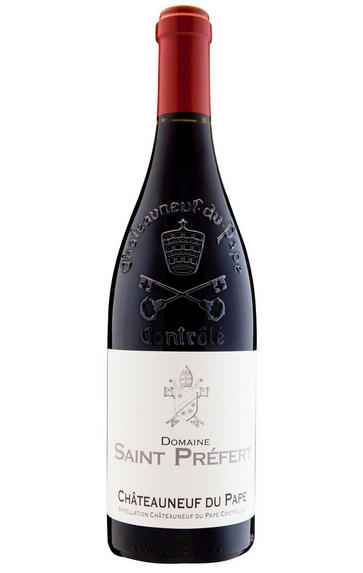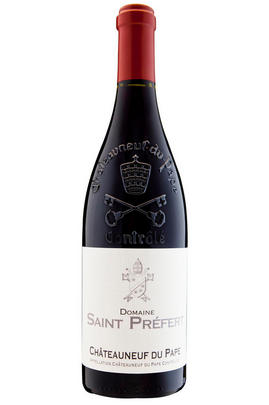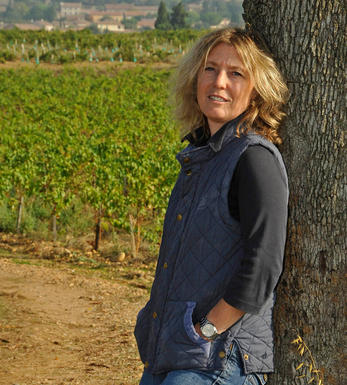
2015 Châteauneuf-du-Pape, Cuvée Classique, Domaine Saint Préfert, Rhône

About this WINE

Domaine Saint Prefert
Domaine St Préfert is yet another Châteauneuf-du-Pape A-lister on our ever-expanding Rhône wine range. Isabel Ferrando’s vines are mainly located in the southern sector; her modus operandus is fairly traditional with no destemming, cement tank maturation and a taste for déléstage. Her outlook and temperament, however, fall into the more modern camp, as manifested by the multiplicity of differing ‘cuvées’, all, thankfully pleasingly different from each other.
Châteauneuf-du-Pape Cuvée Classique comes from (relatively) younger vines and is a blend of 85% Grenache and 5% each of Syrah, Mourvèdre and Cinsault. It is a charming showcase for Grenache at is most bounteous; Châteauneuf-du-Pape, Reserve Auguste Favier is a charming blend of Grenache and 15% Cinsault. The Châteauneuf-du-Pape cuvée Giraud includes 38% of Mourvèdre that adds dark-fruit power and spicy, savoury tannins.

Châteauneuf-du-Pape
The most celebrated village of the Southern Rhône, Châteauneuf-du-Pape is the birthplace of the now indispensable French Appellation d’Origine Contrôlée system – imperfect though it may be. Compared to the Northern Rhône, the vineyards here are relatively flat and often feature the iconic galet pebbles – the precise benefits of which are a source of much debate. Minimum alcohol levels required by the AOC are the highest in France, but at 12.5% it is well below the natural generosity of Grenache, which only achieves its full aromatic potential when it is fully ripe and laden with the resultant high sugars. Syrah and Mourvèdre contribute the other defining elements in the blend, adding pepper, savoury spice and structure to the decadent Grenache. There are a further 10 permitted red grape varieties which can be used to adjust the “seasoning”. Of the five white varieties permitted, it is Grenache Noir’s sibling – predictably perhaps – Grenache Blanc, which dominates, though Roussanne shows a great deal of promise when handled well, notably at Château de Beaucastel.

Southern Rhône Blend
The vast majority of wines from the Southern Rhône are blends. There are 5 main black varieties, although others are used and the most famous wine of the region, Châteauneuf du Pape, can be made from as many as 13 different varieties. Grenache is the most important grape in the southern Rhône - it contributes alcohol, warmth and gentle juicy fruit and is an ideal base wine in the blend. Plantings of Syrah in the southern Rhône have risen dramatically in the last decade and it is an increasingly important component in blends. It rarely attains the heights that it does in the North but adds colour, backbone, tannins and soft ripe fruit to the blend.
The much-maligned Carignan has been on the retreat recently but is still included in many blends - the best old vines can add colour, body and spicy fruits. Cinsault is also backtracking but, if yields are restricted, can produce moderately well-coloured wines adding pleasant-light fruit to red and rosé blends. Finally, Mourvèdre, a grape from Bandol on the Mediterranean coast, has recently become an increasingly significant component of Southern Rhône blends - it often struggles to ripen fully but can add acidity, ripe spicy berry fruits and hints of tobacco to blends.


Buying options
Add to wishlist
Description
Isabel certainly has a penchant for making several cuvées, understandably, given the diversity of the terroir at her disposal. It is, however, reassuring that her “entry-level” wine is so good. It brings to mind the aromas of a Provençal market place without the noise. Drink 2020-2028.
Simon Field MW - Wine Buyer
The growing stature of Isabel Ferrando in this large village is bolstered by increasing international accolades, and, maybe even more importantly, by the generosity of the commentaries of her peers. Isabel Ferrando’s vines are mainly located in the southern sector; her modus operandi is fairly traditional with no de-stemming, cement-tank maturation and a taste for délestage (rack and return). Her outlook and temperament, however, fall into the more modern camp, as manifested by the multiplicity of differing cuvées, all, thankfully pleasingly different from each other.
wine at a glance
Delivery and quality guarantee